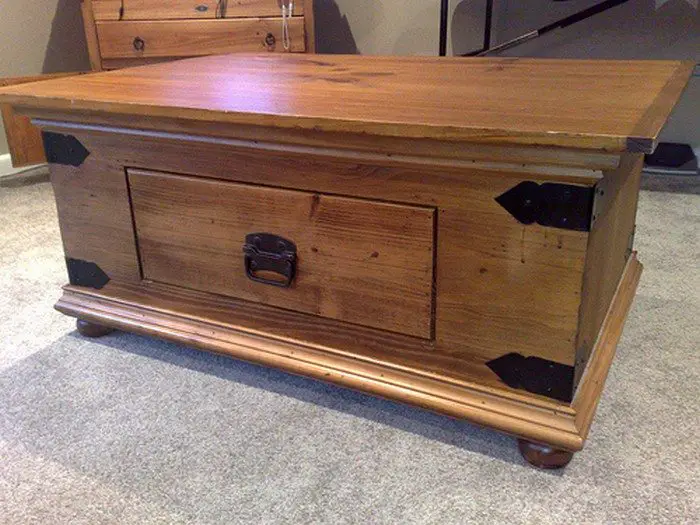
“Coffee table”… that phrase has to be one of the all-time great misnomers! The one thing that I rarely see on our coffee table is coffee. But I do frequently see game controllers, tablets, laptops, and of course, everything from a quick snack to a full-blown meal on it!
That’s why this idea really appealed to me when I first saw it. For starters, it offers an instant end to that aching back that comes from being hunched over your keyboard. And what about when the kids convince you that they should eat their dinner in front of the TV? Is it only our household where their clothes and the floor seem to eat better than they do, as they try unsuccessfully to negotiate fork to mouth while their brain is engaged in a digital world?

And as a bonus, all the remotes and game controllers can be stored in the table (assuming, of course, I yell often and loud enough to create the habit)!
In this example, an existing table/chest has been converted. But it’s an easy project for anyone starting from scratch. And it doesn’t have to be expensive. In fact, it can be made for less than most store-bought, single-function, coffee tables.
Click on any image to start the lightbox display. Use your Esc key to close the lightbox. ?

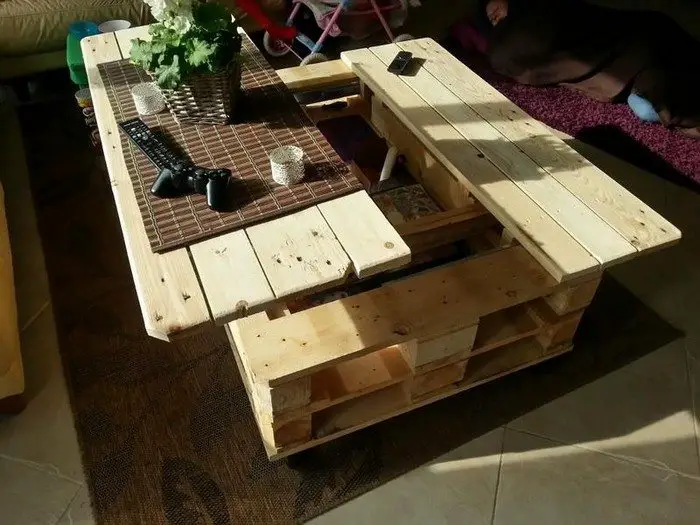
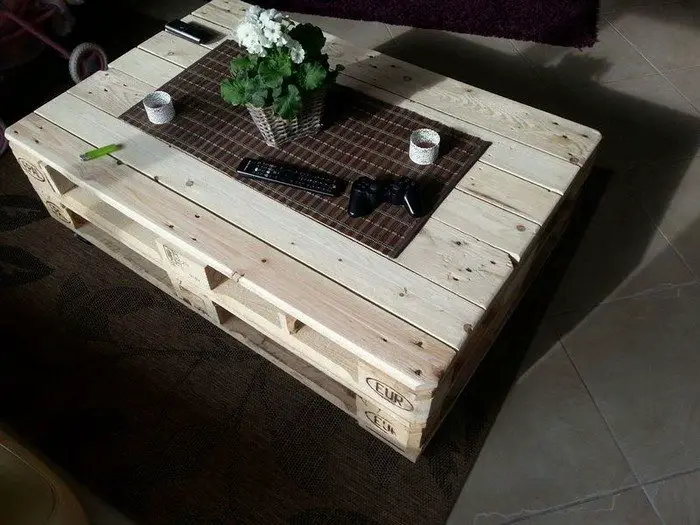

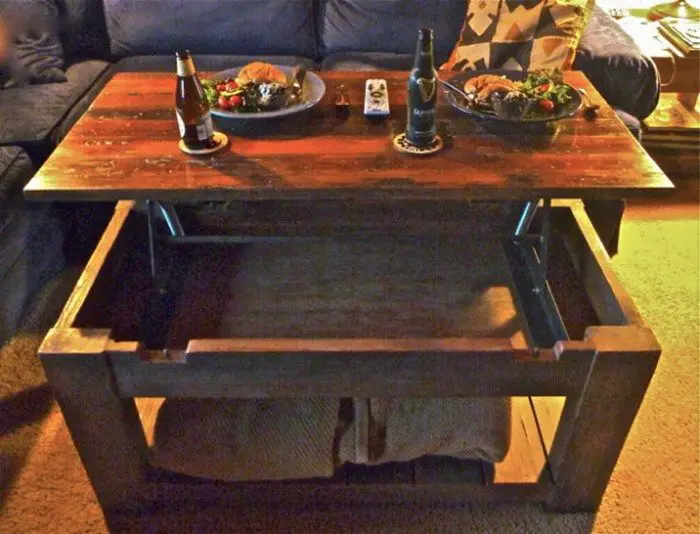
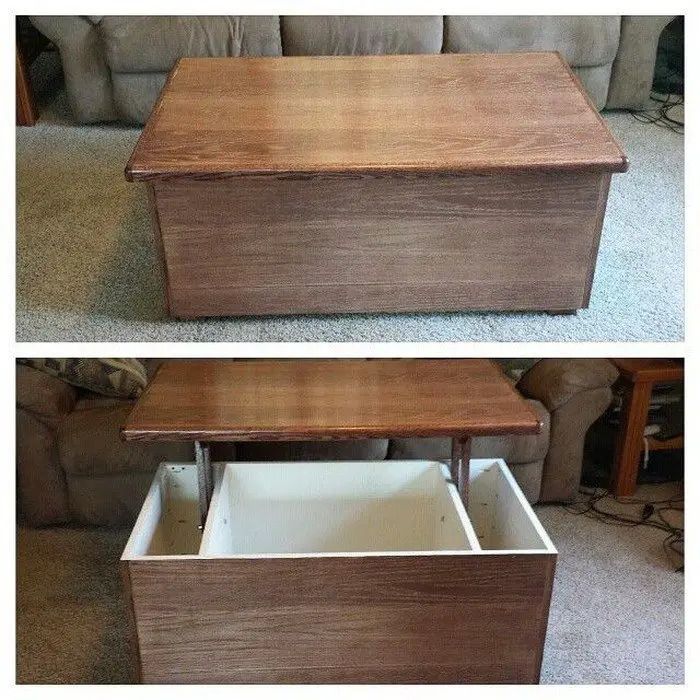
- Screw drivers (electric is going to make it easier)
- Hammer
- Paint Brush
- Saw (Mitre and box or drop saw if you have one)
- Possibly a pinch bar if you are modifying an existing table.
- Case:
Can be made from ply, MDF or even timber panelling
Long sides – 2 pcs – 16×40 in
Short sides – 2 pcs – 16×24 in
The top – 1 pc – 28×44 inPanel thickness:
A 3/4 inch thickness is enough for a stable coffee table like this. You can get away with 5/8 if you want but the savings will probably be marginal.
- Hardwood (for the cantilever hinge)
- Any extra timber and ply required for shelves etc.
- Replacement timber for any bits you damage
- Sand paper
- Wood glue
- Wood stain (of your choice, better if water-based)
- Varnish (there are different finishes, think about which to buy)
- NOTE: There are also 2-in-1 products you can buy, serving both as stain and varnish
- Bolts
- Nyloc nuts
- Bullet head nails
- Screws (1-1/2 inch and 2 inches long)
- Drawer handles
- Drawer slides
- Corner straps (get nice-looking ones that would fit the design you have in mind)
Things you might need (if you are working with recycled timber):
- Wood filler
- Belt sander
- Paint stripper
- Pinch bar
- Caster wheels (if you want this on wheels)
Steps:
Measurements stated here are applicable only for the table shown. Adjust accordingly to your needs. Don’t forget to consider the caster wheels when computing for the (open and closed) height of your table.
The first thing you need to build is, of course, the main body like the one shown in the picture. But before joining the four panels, you have to determine the measurement of your drawer opening and cut the hole first – especially if you want your drawer to slide through both sides. This will ensure both holes are equal. You also want to make sure that it will be exactly at the center. Leave more space at the top if you want to have a deeper tray beneath the table top.
If you want a cleaner look for joining the panels – meaning hiding the panel’s raw edges – you would need a mitre saw and box. For a better understanding of wood joints click here.

When you have the main body already, start working on the hinge. Use the hardwood for this. Make sure to consider the table height as it is extended. You want to be comfortable with table height while seating – not too high and not too low.
For the part of the hinge which will be attached to the table’s main body, the length should be equal to the gap of the longer sides. The piece that will hold the table top itself should have only a little less than that measurement. Trust your judgement and skills to determine the right measurement for the hinge parts. Use the nyloc nuts for the mechanism. This is what it should look like:
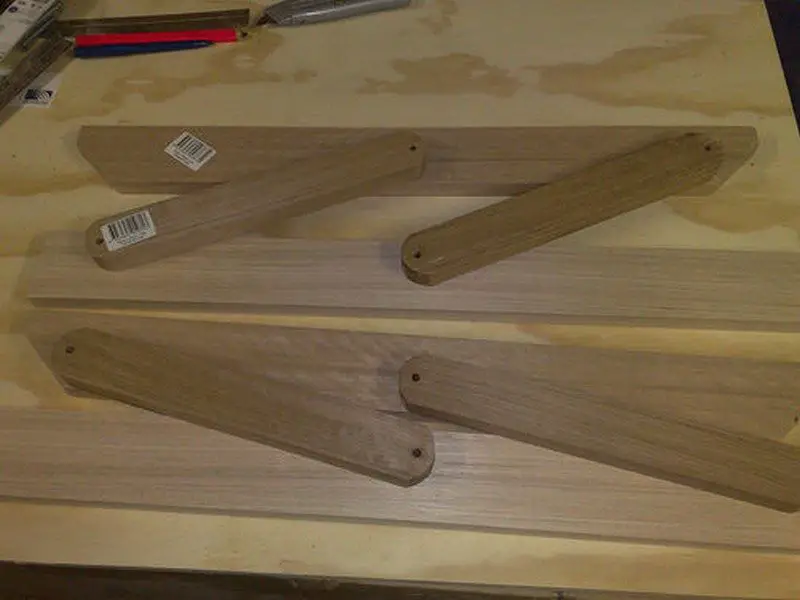
Now the tray shelf. You can try house joints in creating the shelf. If not, butt joints are always the easiest. Just make sure to provide wood support under the shelf, like in the first picture of this post. Attach the support and shelf to the main body with the wire nails.

Depending on the main body’s size, your table top should have an excess of at least two inches per side for you to be able to pull it up.

For the drawer, play around with dimensions here until you are sure that they are right. Consider leaving some space for the routed edges if you are planning to add that to your design.
Create ledges for the drawer slides. Butt-join two pieces of wood which have lengths that are equal to the gap of your long sides. Fasten it to the main body. See the first picture as an example.
You might want to provide the same sizes of wood for the top edge of your drawer as a stopper, thus preventing the drawer from tipping when it is half open.

Before you assemble everything, stain and varnish them with the finish that you desire.

Then install the caster wheels (if you plan to), hinge, table top, drawer handle and finally the corner straps.

Other notes:
- For the fancy edging that you see here, you have to go to your local carpentry/home hardware store and get some edging. You need enough to go around the top and bottom edges (depending on the look you are going for). You will also need to mitre cut this, making sure it fits exactly to the main body.
- Use wood glue to add to the strength of your furniture.
- If you plan to build this table with wheels, make sure not to buy ones that are too big. The wheels will tend to go further at the center of the table, thus reducing stability, as it gets bigger. Trust your judgement in determining the size which is small but enough to support the weight of the entire table.
- To attach the caster wheels, make a triangle at the inside bottom corners of the main body by attaching a piece of wood, cut diagonally, both on the longer and shorter side. This is where you will screw the metal plate of the wheels, so size of that wood will depend on the size of the metal plate. You will need 2-inch or longer screws to get through your 3/4-inch panels and a decent depth into your triangle.
Thanks to Lofgren for the original idea!
Here’s a quick video…






